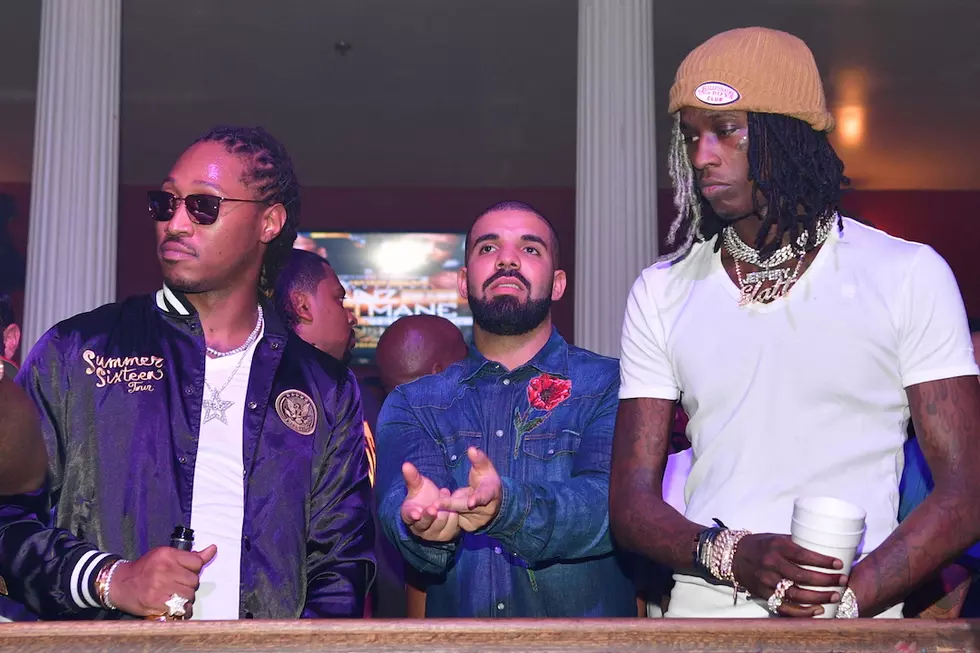
How Hip-Hop Production Became All About the Vibes in the 2010s
In the 2010s, a hoard of bold, genre-bending artists helped shift rap music into a more melody-driven genre. By the mid-2010s, many hip-hop fans didn’t know what to make of Young Thug’s incoherent, tongue-twisting exploits on “Danny Glover” or Rich Gang’s “Lifestyle.” They were similarly flummoxed by Travis Scott’s complimentary presence on his own immersive production on Rodeo.
That influx of harmony dovetailed with the superstardom of pensive rhymers like Kendrick Lamar, Drake and Future, who represented the millennial generation’s collective angst through their confessional catalogs. Their philosophical musings and romantic travails forged a blueprint on which an entire generation of young artists built later in the decade. Whereas 2000s G.O.A.T.s like Jay-Z, Lil Wayne, 50 Cent and others were beating the beat up, the 2010s saw artists who sought consolation in them.
Murky synthesizers and samples that sounded like they were drowning defined the 2010s thanks to producers like Noah “40” Shebib and Metro Boomin, who helped shape those worlds fit for emotional dumping with slick filtering and EQ techniques. Artists and producers collectively popularized an ominous soundscape that lured listeners and inspired vulnerable lyricism. In this decade, new horizons in hip-hop production meant getting atmospheric.
Filtered samples and synths have characterized the decade’s biggest hits, from songs like Kendrick Lamar’s “Swimming Pools” (4x platinum), Travis Scott’s “Antidote” (4x platinum), A$AP Rocky’s “Fuckin Problems” (5x platinum) and Future’s “Trap Niggas ” (gold). While there have been other popular sounds like Young Money’s syrupy earworms of the early 2010s, Mustard’s bouncy, Bay-influenced production and a slew of passing sonic fads, atmospheric production became mainstream rap’s chief sound through sheer volume. It’s been the constant. Drake opened the decade with “Karaoke,” and closed it with “Omertà.” From the beginning of the decade to the end, artists and producers have been submerging sounds to engrossing effect.
Drake and 40 played a chief role in canonizing the sound, continuously building upon So Far Gone and Kanye West’s 808s & Heartbreak throughout the decade. Together they perfected a cavernous sound fit for Drake’s existentialism and romantic musings. The trials of love are a predominant theme of Drake’s music, and his cloudy forays parallel the conflicting, consuming emotions of romance. For instance, 40’s blooming synths and deep drums are the perfect springboards for Drake’s manipulative drunk dialing on “Marvin’s Room.”
Consider the contrast between hip-hop hits from the mid-aughts with those that characterize the 2010s. While UGK and OutKast’s 2007 classic, “International Player’s Anthem,” is built on a clean, gleaming Willie Hutch sample, Ellie Goulding’s enchanting vocals in Drake’s Boi-1da-produced “Pound Cake” lulls listeners into Drake’s azure, where caviar wishes and champagne dreams roll off the tongue.
Kanye’s 2005 smash “Gold Digger” casts Jamie Foxx’s Ray Charles impersonation as the song’s centerpiece (a trick he rehashes for songs like 2011’s “Otis”)—a stark foil to how 40 subtly incorporates Ginuwine’s “So Anxious” in Drake’s “Legend.”
It’s fitting that Drake collaborated with Future, another purveyor of 2010s mood music, on 2015’s What A Time To Be Alive. Similar production techniques have also defined Future’s catalog. The Atlanta rhymer is one of the decade’s chief deliverers of pensive confessionals. Producers like Metro Boomin, Zaytoven and Mike WiLL Made-It have crafted him beats that fit his drug-addled lamentations. His run of solo projects between 2015 and 2016—Beast Mode, 56 Nights, DS2, Purple Reign and EVOL—was defined by Metro’s searing, dark production. It was the perfect canvas for Future to cull the depths of the drug trade—and his variant dependencies on it.
Future has built a veritable trauma bond with Metro, Mike WiLL and Zaytoven’s eerie keys, despondent synths and trembling 808s. If Drake’s brand of atmospheric production takes us into the unknown, Future’s undoubtedly pulls us toward depths.
Both men have utilized the formula en route to great commercial success. Future has three platinum-certified solo albums and four gold albums. Drake has sold more than 170 million records across the world. While he’s a diverse artist, the brooding, atmospheric sound is his trademark and accounts for a sizable portion of those sales (i.e. the double-platinum single “Marvin’s Room”).
Travis Scott became hip-hop’s latest superstar on the strength of Astroworld, an RIAA-certified triple platinum album boasting hazy singles such as the quadruple-platinum “Butterfly Effect” and platinum “Stargazing.”
Hip-hop’s new school took cues from the success of Drake, Future and La Flare—especially so-called SoundCloud rappers. Artists like Lil Pump, Smokepurrp and Post Malone excel over dark, quaking production typified by tracks like Pump’s “Gucci Gang” and Post Malone’s star-making “White Iverson.” On a more somber end of the spectrum, late cult favorites Juice Wrld (“Lucid Dreams”), XXXTentacion (“Sad!”) and Lil Peep (“Save That Shit”) fused elements of emo rock with a moody trap aesthetic to great success, leaving their young fans wondering where they could’ve taken the sound in the 2020s.
Hip-hop is more fixated on vibes than ever in the 2010s—see 2 Chainz's 2017 track "It's a Vibe," PNB Rock's Catch These Vibes from the same year and XXXTentacion's posthumous, decade-capping Bad Vibes Forever earlier this month. Producers deserve credit for providing the evocative soundscape for the decade’s most resonant artists. That atmospheric production became the perfect foil for ruminations of discontent and the lofty aspirations of dream chasers, helping to make hip-hop fans feel like they were wading in an abyss of emotions, right along with their favorite artists. —Andre Gee
See 45 Most Important Producers Since 2000
More From XXL









